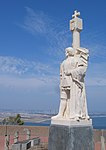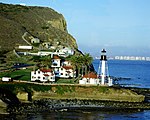Point Loma, San Diego

Point Loma (Spanish: Punta de la Loma, meaning "Hill Point"; Kumeyaay: Amat Kunyily, meaning "Black Earth") is a seaside community within the city of San Diego, California. Geographically it is a hilly peninsula that is bordered on the west and south by the Pacific Ocean, the east by the San Diego Bay and Old Town, and the north by the San Diego River. Together with the Silver Strand / Coronado peninsula, the Point Loma peninsula defines San Diego Bay and separates it from the Pacific Ocean. The term "Point Loma" is used to describe both the neighborhood and the peninsula. Point Loma has an estimated population of 47,981 (including Ocean Beach), according to the 2010 Census. The Peninsula Planning Area, which includes most of Point Loma, comprises approximately 4,400 acres (1,800 ha).Point Loma is historically important as the landing place of the first European expedition to come ashore in present-day California. The peninsula has been described as "where California began". Today, Point Loma houses two major military bases, a national cemetery, a national monument, and a university, in addition to residential and commercial areas.
Excerpt from the Wikipedia article Point Loma, San Diego (License: CC BY-SA 3.0, Authors, Images).Point Loma, San Diego
Cabrillo Memorial Drive, San Diego
Geographical coordinates (GPS) Address Nearby Places Show on map
Geographical coordinates (GPS)
| Latitude | Longitude |
|---|---|
| N 32.67 ° | E -117.24194444444 ° |
Address
Cabrillo National Monument
Cabrillo Memorial Drive
San Diego
California, United States
Open on Google Maps










